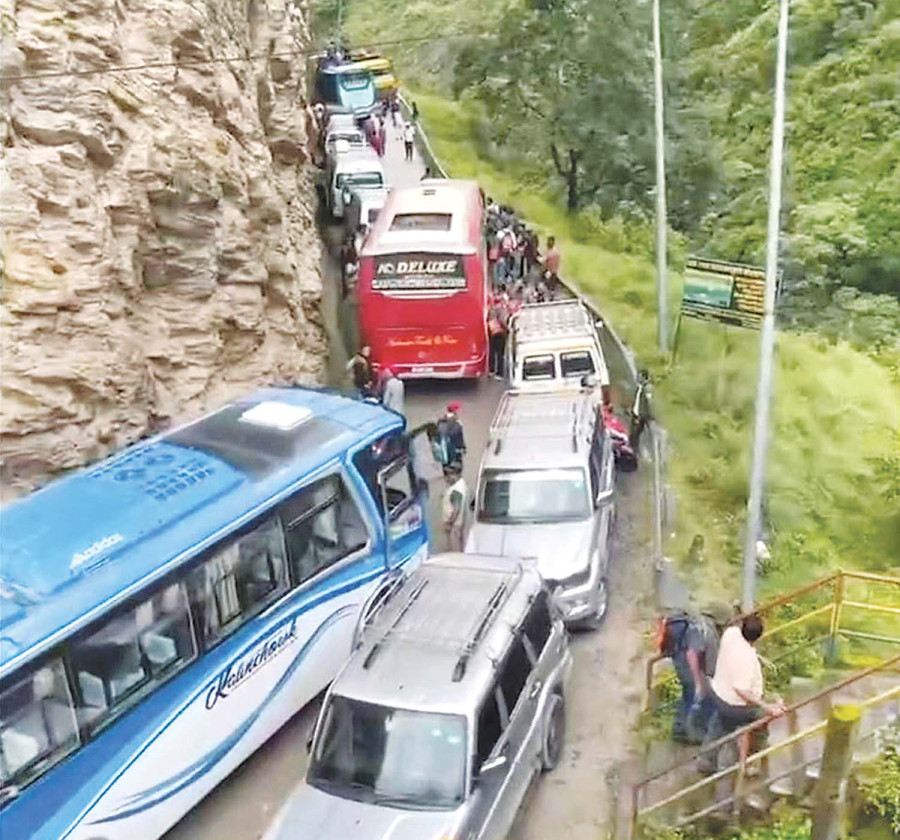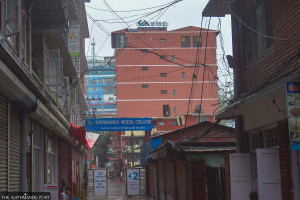Money
Pilgrims and containers stuck on Nepal-China border roads
Traders diverted shipments to Tatopani after floods damaged the Kerung route, but ongoing landslides and traffic jams have left over 1,100 containers and hundreds of pilgrims stranded.
Krishana Prasain
Around 1,100 containers loaded with festive goods are currently stuck along the Nepal-China border, raising concerns among Nepali traders ahead of Dashain, which begins in late September.
Traders say 600 standard cargo containers are between Nyalam County in Tibet and Kodari in Nepal. The narrow, landslide-prone route has become even more congested due to the influx of Indian pilgrims travelling to Kailash Manasarovar via the Tatopani border.
According to traders, nearly 400 buses and microbuses carrying over 1,000 pilgrims also contribute to the traffic bottleneck.
After flash floods struck the Rasuwagadhi-Kerung route on July 8, many traders began diverting their shipments to the Khasa-Tatopani crossing starting July 10. The Chinese authorities, who typically limit use of the Tatopani route, temporarily opened it for both trade and pilgrim travel in response to the disruption.
However, the alternative route has proven risky.
Continuous monsoon-triggered landslides and flooding have worsened road conditions on both sides of the border.
The July 8 flash flood, which originated in China, washed away the vital Miteri Bridge and caused severe damage to surrounding infrastructure. The under-construction dry port at Rasuwagadhi, nearly 80 percent complete and funded with a Chinese government grant of around Rs3 billion, was destroyed.
Since the disaster, the Rasuwagadhi customs office has remained closed. Officials say they do not estimate when trade might resume from the Kerung route.
With cargo now diverted to Tatopani, pressure has mounted on that corridor.
Surya Prasad Kafle, information officer at the Tatopani Customs Office, said that nearly 50 goods-laden vehicles are stranded on the Nepali side after a landslide damaged a 300-metre road in Kodari on Sunday.
“The road is expected to reopen by Saturday,” said Kafle. “But since it’s still monsoon season, we cannot predict what might happen next.”
Kafle added that nearly 550 cargo containers are stuck in Nyalam, China, due to traffic congestion on the Khasa side.
“The increased movement of pilgrims has worsened the jam. Thousands of Indian pilgrims cross Tibet daily via Tatopani for the Kailash Manasarovar yatra.”
While the Indian government officially promotes the pilgrimage via the disputed Lipulekh Pass and the Nathu La Pass in Sikkim, most pilgrims prefer to travel privately through Nepal. There are four main routes to Kailash Manasarovar via Nepal: Tatopani, Rasuwagadhi, Hilsa, and the Kathmandu-Lhasa flight.
As timely goods delivery remains uncertain, Nepali traders fear significant losses and a price spike—particularly for readymade garments meant for the Dashain shopping season.
In the lead-up to Nepal’s biggest festival, billions of rupees worth of goods—including electric vehicles, clothing, footwear, accessories, and consumer electronics—are stranded on the Chinese side, at Kerung and Khasa.
“We met the finance minister on Thursday and informed him of the problems traders are facing at the northern border,” said Ram Hari Karki, president of the Nepal Trans-Himalayan Border Commerce Association. “He assured us the issue would be addressed, but so far, nothing has changed.”
According to Karki, the Chinese authorities allow very few trucks through, citing poor road conditions on the Nepali side.
“Only a limited number of containers are arriving. Around 150 containers carrying apples are stuck in Lhasa. We are losing hope that Dashain-targeted goods will reach Nepal in time.”
He said the Tatopani road has become unreliable, frequently closing due to landslides and flooding. Meanwhile, approximately 500 containers remain stuck on the Kerung side.
“The Nepali side of the Tatopani road is also in poor condition and prone to frequent disruptions,” Karki said. “And it’s impossible to reroute these shipments via sea, even through India. By the time they reach Nepal, the festive season will end.”
When festival-related goods are delayed, traders are forced to warehouse them for extended periods, significantly increasing their storage costs and reducing profit margins.
According to the Department of Customs, Nepal imported goods worth Rs298.77 billion from China in fiscal year 2023–24. In contrast, exports to China stood at only Rs2.58 billion, resulting in a trade deficit of Rs296.18 billion.




 27.38°C Kathmandu
27.38°C Kathmandu

















